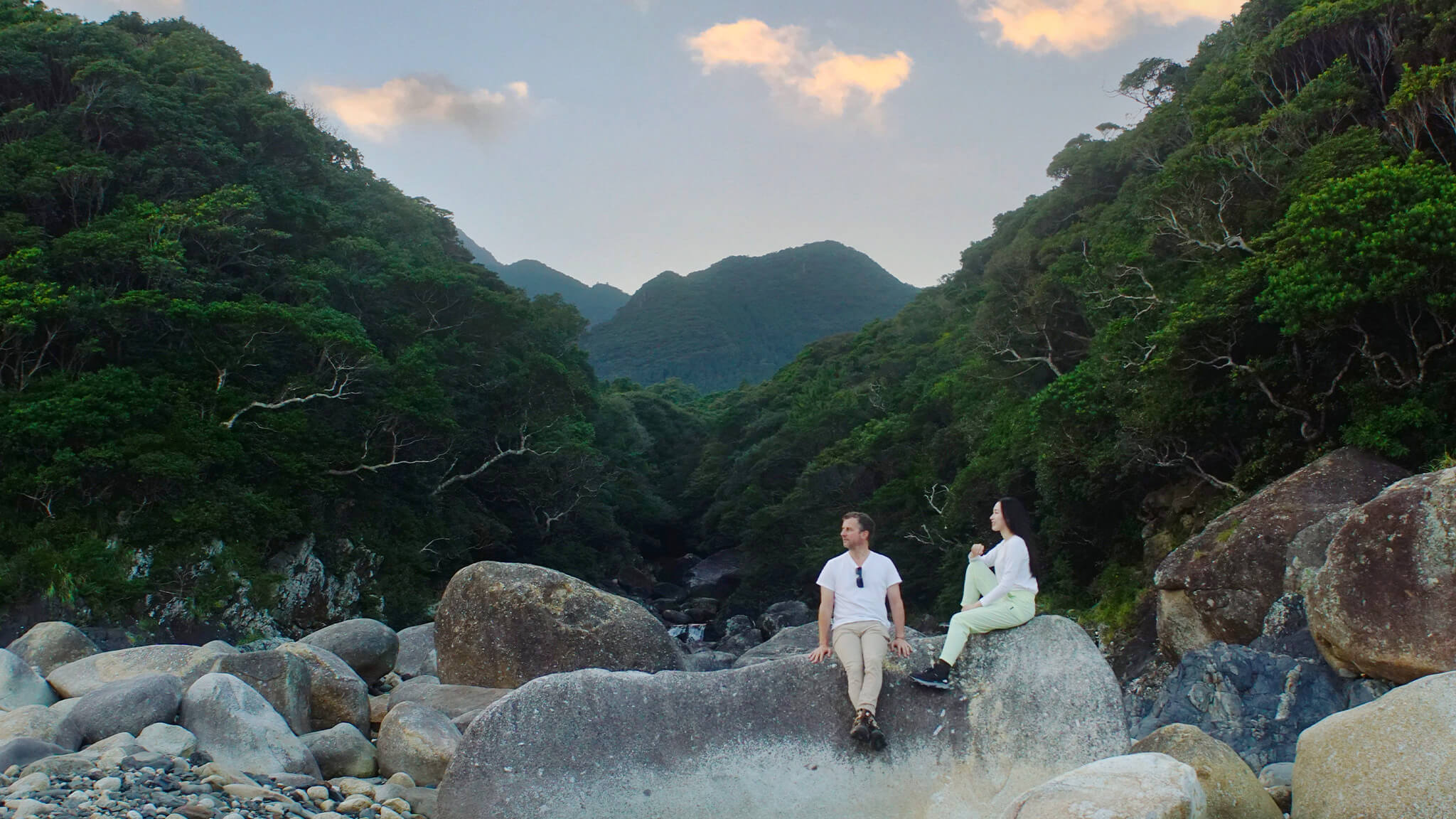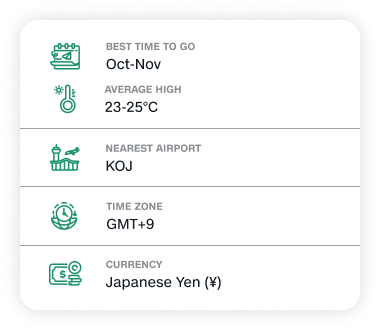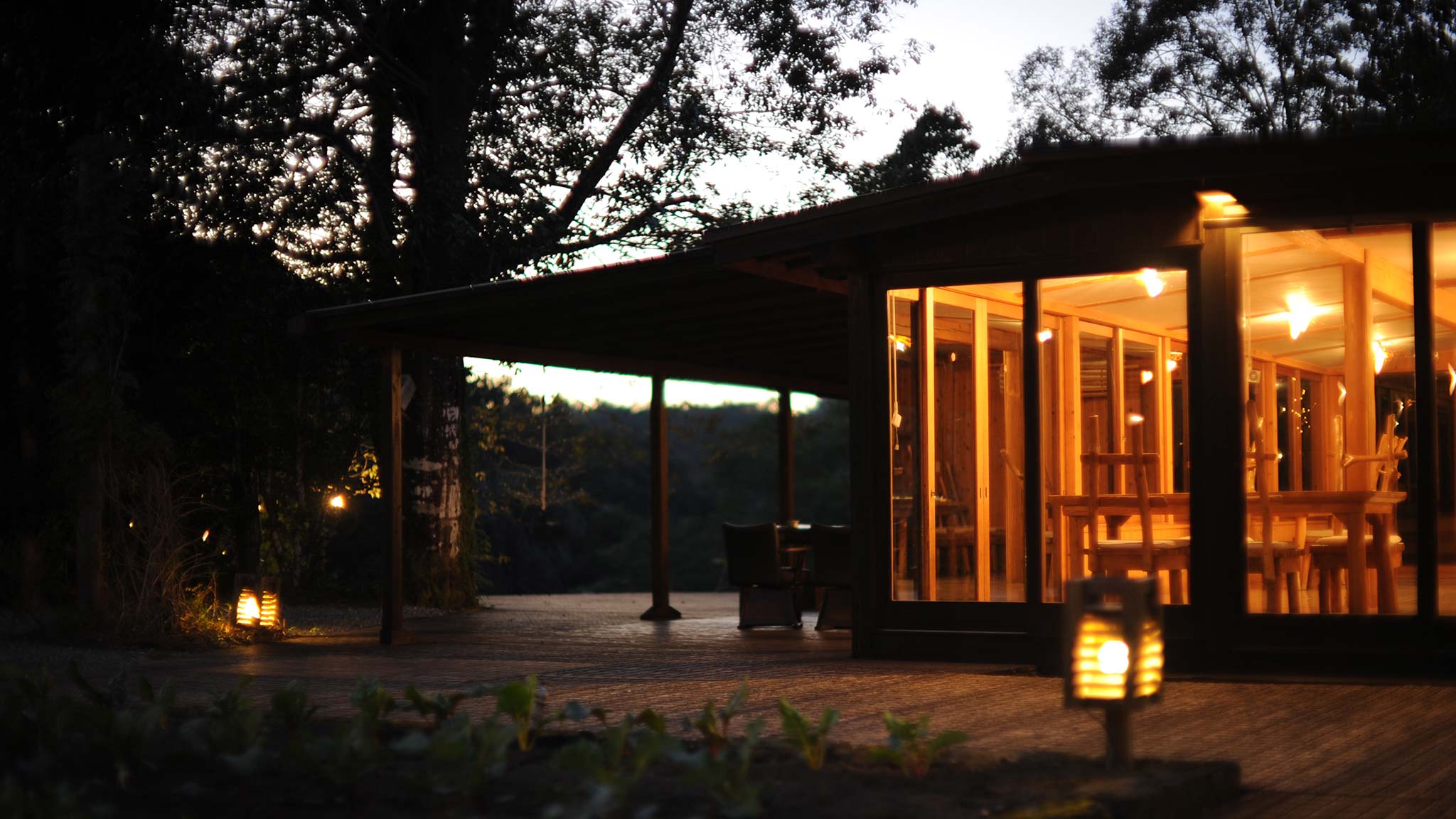
A guide to Kagoshima:
The gateway to Japan’s natural wonders and spiritual connections
With a seamless blend of cultural richness and natural beauty, Japan’s Kagoshima prefecture inspires travelers to embark on a journey of physical and self-discovery.
Known as the land of the rising sun, there is something inherently optimistic about Japan—a notion that is reinforced by the soaring skyscrapers, neon-lit streets, and bustling eateries of its capital Tokyo. But further south, in Kagoshima prefecture, travelers are reminded that the spirit of Japan existed long before its cityscapes; in the natural ecosystems and ancient rituals that have made the country a destination like no other.
Day 1: Journey back to ancient Kagoshima
As the southernmost point of Japan, Kagoshima is uniquely positioned alongside the waters of Kinko Bay, the fire of Mount Sakurajima, and the forest of Yakushima. These elements make it a haven for travelers seeking a diverse itinerary that enables both adventure and reflection.
Arriving in Kagoshima, just two hours from Tokyo International Airport, take the 15-minute drive to Gajoen, a luxury retreat set deep within the wilderness. Inspired by a traditional Japanese village, the complex reminds guests of how life used to be through thatched-roof cottages, free-roaming chickens, and a handcrafted hot bath—cut from a solid 20-ton rock.

While Gajoen is a love letter to authentic Japan from the owner Tateo Tajima, his second hotel Tenku No Mori rewrites the rules of hospitality.
Translating to “Heaven in the Sky”, Tenku offers guests panoramic views of Kagoshima’s volcanic mountains and forest canopy. Whether guests are soaking them in from one of the five secluded villas, from a private hot bath, or over a romantic meal for two, they are encircled by nature.
The dress code of the hotel is “naked”. I would like guests to remove their titles and their egos and realize that they are a part of Earth.
Tateo Tajima, Owner, Gajoen and Tenku No Mori
To Tajima, traveling Kagoshima means experiencing its culture. At the stately home Sengan-en, visitors are invited to follow in the footsteps of the Shimazu Clan who resided here in the 17th century. Against the backdrop of the Sakurajima volcano, they can explore 12 acres of beautiful gardens, bamboo groves, and mountain trails that maintain the legacy of these ancient settlers.
Travelers can continue their journey to the past at the family-run restaurant Sanei. Having served customers for more than 90 years, third-generation chefs are still dedicated to using Kagoshima’s locally sourced and seasonal ingredients, while creating signature recipes like seabream soup. With a simple mission to provide good food, good service, and be good-hearted, Sanei is an ideal way to end a day of cultural awakening.
Day 2: Uncover local secrets in Yakushima
Across the waters from Kagoshima lies the UNESCO World Heritage Site, Yakushima National Park. Reachable via a two-and-a-half-hour ferry or 40-minute flight, travelers are met with a mountain landscape that is as dramatic as it is picturesque.

To make the most of your experience, book one of the many specialized tours of Yakushima led by qualified guides. As guardians of the island, they will not only teach you how to preserve its delicate environment but where to find its best-kept secrets.
Hidden just south of Yakushima Airport is the lesser-known spot Crystal Cape. Visitors can carefully navigate the craggy route, taking in the layered and colorful rocks as they go. Upon reaching the coastline, they are rewarded with a breathtaking panorama of the sea, which in February and March, may even offer views of whales breaching the surface.

Further inland, Sankara Hotel and Spa is a perfect opportunity to recharge, promising guests a premium stay that is conscious of their needs and the environment. Find tranquility in the outdoor sauna, infused with ginger oil from Yakushima’s forest, before preparing for an unforgettable dining experience at the chef’s table (Okas) or poolside restaurant (Ayana).
Ayana found its niche by reinventing European classics with Yakushima’s abundant ingredients. Chefs serve intricate dishes, including pasta filled with local seafood and sunchoke salad with smoked flying fish—an island delicacy.
As night falls, travel to Hirauchi Kaichu Onsen, a natural hot spring next to the ocean. Available two hours before and after low tide, make the most of this unique opportunity to bathe under the stars.
Day 3: Allow the forest to awaken your senses
A trip to Yakushima would be incomplete without discovering the forest that makes up around 90% of the island. Just be sure to plan for all weather conditions as the subtropical climate brings frequent rain showers.

Although high-octane experiences are available like trekking to the Taiko-iwa boulder or kayaking on the Anbo River, shinrin-yoku, or forest bathing, is the standout activity in the area. Over a two/three-day period, travelers are led by guide company Kaleidoscope through a series of meditative practices known as deep-Shinrinyoku, sensory check-ins, and silent excursions to align their selves with the wilderness.
The Shiratani Unsuikyo Ravine is a popular destination for shinrin-yoku. Travelers can ground themselves to the cushiony moss bed, feel their way over the entwined roots of millennia-old cedar trees, hear the distant call of Yakushima macaque monkeys, and taste the spring water from a nearby stream.
Ultimately, it’s about slowing down to bring yourself into the present. With this focused perspective, shinrin-yoku is said to reduce stress, increase immunity, and improve sleep.
Follow up a day of relaxation at the plant-based restaurant, a heavenly kitchen. With the atmosphere of a family home, diners are welcomed into a small dining room, before tucking into a lovingly prepared meal that promises color, flavor, and nutrition.
Complete your Yakushima adventure in a place that exists to maintain the heart of the island; Sumu. This experimental housing cooperative, shaped by the landscape and committed to its preservation, encourages guests to live as locals once did—with the wind, ocean, and rivers that keep the forest alive. As part of this community, guests can collect driftwood for the nightly bonfire, a ritual that infuses the site with the smell of cedar, and the symbol of Yakushima.

Whether you seek the serenity of a tranquil garden, the stimuli of the inner forest, or the authenticity of Japanese living, Kagoshima is an invitation to dive deeper into the landscapes and traditions that make this remarkable corner of Japan a place to remember.























